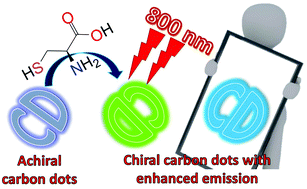Chiral carbon dots based on l/d-cysteine produced via room temperature surface modification and one-pot carbonization†
Abstract
Since chirality is one of the phenomena often occurring in nature, optically active chiral compounds are important for applications in the fields of biology, pharmacology, and medicine. With this in mind, chiral carbon dots (CDs), which are eco-friendly and easy-to-obtain light-emissive nanoparticles, offer great potential for sensing, bioimaging, enantioselective synthesis, and development of emitters of circularly polarized light. Herein, chiral CDs have been produced via two synthetic approaches using a chiral amino acid precursor L/D-cysteine: (i) surface modification treatment of achiral CDs at room temperature and (ii) one-pot carbonization in the presence of chiral precursor. The chiral signal in the absorption spectra of synthesized CDs originates not only from the chiral precursor but from the optical transitions attributed to the core and surface states of CDs. The use of chiral amino acid molecules in the CD synthesis through carbonization results in a substantial (up to 8 times) increase in their emission quantum yield. Moreover, the synthesized CDs show two-photon absorption which is an attractive feature for their potential bioimaging and sensing applications.

- This article is part of the themed collection: 2021 Nanoscale HOT Article Collection


 Please wait while we load your content...
Please wait while we load your content...